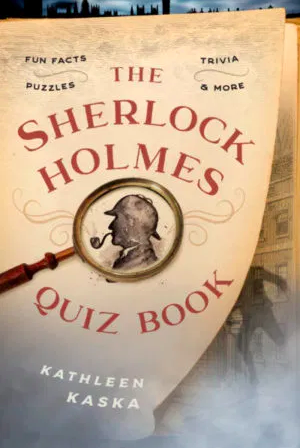
Sherlock Holmes, detective for the ages
“The whole Sherlock Holmes saga is a triumphant illustration of art's supremacy over life. Perhaps no fiction character ever created has become so charmingly real to his readers. It is not that we take our blessed Sherlock too seriously; if we really want the painful oddities of criminology let us go to Bataille or Roughead. But Holmes is pure anesthesia.” (From Christopher Morley’s In Memorandum: Sherlock Holmes)
In 1887, Arthur Conan Doyle published his first Sherlock Holmes novel, A Study in Scarlet, which appeared in Beeton’s Christmas Annual. He went on to publish three more novels and 56 short stories, featuring the character who has become known as the world’s greatest detective. Since then, these stories have been adapted for radio, stage, television, and film; and their characters featured in hundreds of pastiches and parodies. It seems the more Sherlockians have, the more they want.
 In my newly updated book, The Sherlock Holmes Quiz Book, I discuss where Conan Doyle got his ideas and what influenced his writing. I’ve also included trivia on the adaptations of his work since his first publication 133 years ago.
In my newly updated book, The Sherlock Holmes Quiz Book, I discuss where Conan Doyle got his ideas and what influenced his writing. I’ve also included trivia on the adaptations of his work since his first publication 133 years ago.
Holmes has been portrayed as an introverted, intuitive, modern detective residing at Baker Street; a recovering drug addict living in New York City and working as a NYPD consulting detective; a retiree married to a much younger woman; a Japanese female detective; and a Jack Russell terrier. As with Holmes himself, many of his compadres—Mycroft Holmes, Professor James Moriarty, and Inspectors Lestrade and Gregson—have evolved. But the most notable changes appear regarding the female characters: Mary Morston, Dr. Watson’s first wife; Mrs. Hudson, Holmes’ insufferable landlady; and Irene Adler, the only woman to ever beat Holmes at his game.
Portrayed as a typically helpless Victorian lady in some early adaptations, Mary Morston (Kelly Reilly), who stars in Guy Ritchie’s Robert Downey Jr. films, is a now witty figure who outshines her husband in intellect. In the BBC’s Sherlock, she’s an ex-assassin played by Amanda Abbington.
In the original stories, Mrs. Hudson was relegated to serving tea and whining about Holmes’ annoying habits. In Sherlock, Mrs. Hudson (Una Stubbs) maintains these traits, but with a notorious background as a widow of a Florida drug lord. Appearing in only three episodes of CBS’s Elementary, Mrs. Hudson (Candis Cayne), leaves a memorable impression as a stunningly gorgeous transgender person with OCD.
Irene Adler (Rachel McAdams) is Holmes’ romantic interest in Ritchie’s films, and in Sherlock, Adler (Lara Pulver) knocks the emotionless Sherlock for a loop as a dominatrix.
And finally there’s the venerable Dr. John Watson, a time traveler like the other characters, who has evolved very little (except for being a female in Elementary and Miss Sherlock). No matter his portrayal, he has remained steadfast and true, always at Holmes’s side.
I often wonder what Sir Arthur Conan Doyle would have thought of the entertainment treasure chest created from his original Sherlock Holmes, who was then, now, and always for the ages.
Kathleen Kaska writes the award-winning Classic Triviography Mystery Series featuring Alfred Hitchcock and Sherlock Holmes and the Sydney Lockhart Mystery Series, as well as an animal rights mystery series beginning with Run Dog Run. Her nonfiction biography, The Man Who Saved the Whooping Crane: The Robert Porter Allen Story, was published by University Press of Florida in 2012. Kaska splits her time between her two favorite places, the Pacific Northwest and the Texas Coast.


